Short Life Working Group On Prescription Medicine Dependence And Withdrawal: consultation
This consultation seeks views on the draft recommendations from the expert Short Life Working Group convened to make recommendations on addressing prescription medicine dependence and withdrawal.
Annex A - Analysis of available data
1. Analysis on Prescribing prevalence and trends
1.1 Introduction
1.1.1 Public Health Scotland (PHS) performed a series of analyses on Scottish prescribing data for antidepressants, benzodiazepines, gabapentinoids, opioid pain medicines and z-drugs. These are the same five medicines classes included in the Public Health England (PHE) evidence review: www.gov.uk/government/publications/prescribed-medicines-review-report.
1.1.2 PHE shared their methodologies and data outputs with PHS so that these could be replicated with Scottish data as far as possible and to allow appropriate comparisons.
1.1.3 The first part of these analyses looks at the prevalence of prescribing (the proportion of the adult population being treated) for these medicines groups and the trend in prevalence over time. An adult was defined as an individual aged 18 years or over.
1.1.4 NHS England prescription data has individual level data available from 2015 and so PHE had three years of data available for analysis in 2019. Within Scotland, we have individual level prescription data available from 2010 and so we made use of this greater period for analyses, for example in exploring trends in prescribing.
1.1.5 In contrast to PHE, who used a one-month gap as an indicator of treatment course separation, we applied a three-month gap. This was to reflect Scottish prescribing habits, where 56-day prescriptions are not unusual and would result in frequent one-month gaps being present during prolonged treatment courses and lead us to wrongly conclude that treatment had ended. These one month gaps would likely extend to three month gaps for occasions when individuals are issued double prescriptions to cover events such as holidays. (See Annex A1)
1.1.6 In both analyses, individuals with a diagnosis of cancer were excluded from the opioid pain medicines analysis. This approach was taken to exclude palliative use, which is considered an entirely appropriate use of these medicines. Individuals were excluded if they had a cancer diagnosis up to five years before or six months after the prescription issue, or if they had died within 12 months of the prescription with cancer being registered as a reason for death.
1.1.7 For benzodiazepines, PHE excluded prescriptions written on an FP10MDA prescription, which is used for individuals being treated as part of a drugs recovery programme. An equivalent prescription type does not exist in Scotland and no other methods have been used to identify such individuals, therefore they are included in the Scottish analyses.
1.2 Prevalence
1.2.1 The prevalence of prescribing for each of the five classes of medicines is shown in table 1.1 as the proportion of adults in Scotland who received at least one prescription in 2019/20.
| Class | Proportion of population | Adults | Ratio |
|---|---|---|---|
| Antidepressants | 21.6% | 960,000 | 1:5 |
| Benzodiazepines | 5.0% | 225,000 | 1:20 |
| Gabapentinoids | 4.1% | 180,000 | 1:25 |
| Opioid Pain Meds | 17.8% | 790,000 | 1:6 |
| Z-drugs | 3.2% | 145,000 | 1:30 |
| Any | 33.8% | 1,500,000 | 1:3 |
1.2.2 Overall, in 2019/20 almost 34% (1 in 3) of the Scottish adult population received a prescription for a drug from at least one of the 5 medicines classes. This ranges from about 1 in 5 of the adult population for antidepressants to 1 in 30 for z-drugs.
Comparison with England
1.2.3 The latest corresponding data available for NHS England is 2017/18 and is shown in table 1.2. Comparisons with England are therefore based on 2017/18 data for NHS Scotland. In 2017/18 around 1 in 4 adults in England received at least one medication from the 5 classes. This compares to 1 in 3 adults in Scotland.
| NHS Nation | Antidepressants | Benzodiazepines | Gabapentinoids | Opioid Pain Meds | Z-drugs | Any |
|---|---|---|---|---|---|---|
| England | 16.6% | 3.1% | 3.3% | 12.8% | 2.3% | 26.3% |
| Scotland | 19.9% | 5.4% | 4.1% | 19.2% | 3.5% | 33.8% |
1.2.4 In 2017/18 the adult population in Scotland were at least 1.7 times as likely to be in receipt of a benzodiazepine than in England. However, it should be noted that Scottish prescribing includes benzodiazepines prescribed via GPs as part of substance misuse programmes. These individuals are excluded from the data for NHS England. Adults in Scotland were also at least 1.5 times as likely to receive a prescription for opioid pain medicines and z-drugs and at least 1.2 times as likely to receive a prescription for antidepressants and gabapentinoids.
1.3 Effect of Deprivation
1.3.1 Figure 1.1 shows the proportion of the adult population receiving a medicine for each of the five classes by SIMD quintile in 2019/20.
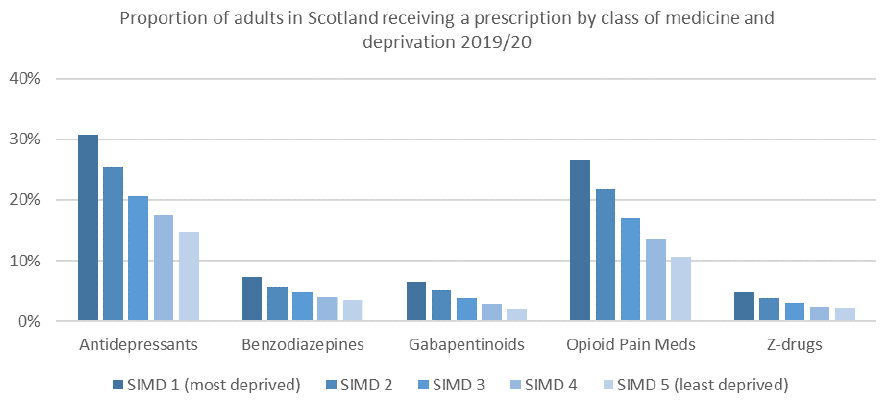
1.3.2 Deprivation has a consistent effect across all five classes of medicine, with higher proportions of those from more socio-economically deprived groups receiving at least one prescription during the year.
1.3.3 This difference is most notable for opioid pain medicines and gabapentinoids. Those from the most deprived communities being 2.5 and 3.0 times more likely, respectively, to receive treatment as those from the least deprived communities.
1.3.4 However, the effect is also marked for the other classes with those from the most deprived communities being more than twice as likely to receive antidepressants, benzodiazepines or a z-drug.
1.3.5 Table 1.3 shows how the difference between the most deprived and least deprived prescribing rates has changed over the past 10 years.
| Financial Year | Antidepressants | Benzodiazepines | Gabapentinoids | Opioid Pain Meds | Z-drugs |
|---|---|---|---|---|---|
| 2010/11 | 2.1 | 2.1 | 2.4 | 2.5 | 2.2 |
| 2011/12 | 2.1 | 2.1 | 2.5 | 2.5 | 2.2 |
| 2012/13 | 2.1 | 2.1 | 2.5 | 2.5 | 2.1 |
| 2013/14 | 2.1 | 2.1 | 2.6 | 2.5 | 2.2 |
| 2014/15 | 2.1 | 2.0 | 2.7 | 2.4 | 2.2 |
| 2015/16 | 2.1 | 2.0 | 2.7 | 2.5 | 2.2 |
| 2016/17 | 2.1 | 2.0 | 2.8 | 2.5 | 2.1 |
| 2017/18 | 2.1 | 2.0 | 2.9 | 2.5 | 2.1 |
| 2018/19 | 2.1 | 2.0 | 3.0 | 2.5 | 2.1 |
| 2019/20 | 2.1 | 2.1 | 3.0 | 2.5 | 2.2 |
1.3.6 The difference in prescribing rates between the most and least deprived areas has been stable over the past 10 years with the exception of gabapentinoids which has increased from 2.4 times as likely to 3.0 times as likely.
Comparison with England
1.3.7 Figure 1.2 shows the proportions of the population being prescribed the five medicines classes by deprivation quintile, as presented in the PHE report for 2017/18. It should be noted that PHE used the patient’s primary care practice deprivation score whereas PHS used the individual patient’s postcode deprivation score. This makes comparisons difficult, if not impossible, as we cannot say what effect this has on the data. English deprivation quintiles are also not directly comparable to Scottish deprivation quintiles as both are calculated across different populations. Comparisons, therefore, should not be made between rates of use for the two nations, rather they should be limited to comparisons of the variation in use across deprivation categories, between nations.
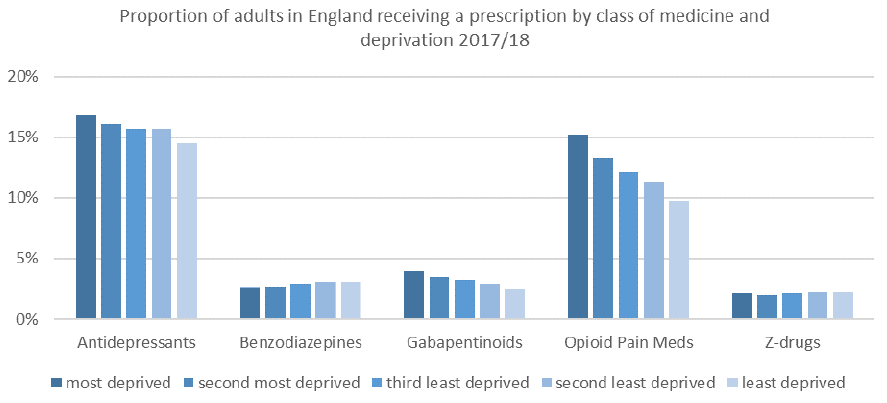
1.3.8 Although antidepressant, gabapentinoid and opioid pain medication prescribing was more prevalent in more deprived compared with less deprived areas in England, the magnitude was less than Scotland, ranging from 1.2 to 1.6 times more prevalent. Benzodiazepine and z-drug prescribing showed the opposite trend with these being more likely to be prescribed in less deprived areas by 1.2 and 1.1 times more likely, respectively.
1.4 Effect of Gender:
1.4.1 Figure 1.3 shows the proportion of the adult population receiving at least one prescription by medicines group and gender.
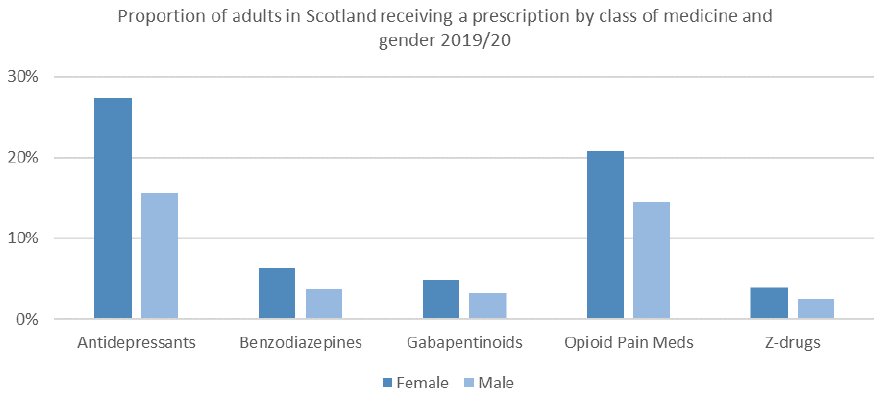
| Financial Year | Gender | Antidepressants | Benzodiazepines | Gabapentinoids | Opioid Pain Meds | Z-drugs |
|---|---|---|---|---|---|---|
| 2010/11 | Female | 20.4% | 7.7% | 2.1% | 21.7% | 3.5% |
| 2010/11 | Male | 10.7% | 4.6% | 1.5% | 14.9% | 2.2% |
| 2010/11 | Female: male ratio |
1.9 | 1.7 | 1.4 | 1.5 | 1.6 |
| 2019/20 | Female | 27.3% | 6.3% | 4.9% | 20.8% | 3.9% |
| 2019/20 | Male | 15.5% | 3.6% | 3.2% | 14.5% | 2.5% |
| 2019/20 | Female: male ratio | 1.8 | 1.7 | 1.5 | 1.4 | 1.5 |
1.4.2 Prescribing rate difference between genders ranged from women being 1.4 times more likely to receive a prescription for an opioid pain medicine, 20.8% versus 14.5% for men, to women being 1.9 times more likely to receive an antidepressant, 27.3% versus 15.5% for men.
1.4.3 Despite changes in volume of prescribing over the ten-year period (table 1.5), the ratio of females to males has remained fairly consistent across all categories.
Comparison with England
1.4.4 Table 1.5 shows that, although English prescribing rates are lower (rates in Scotland were between roughly 1.2 times higher for antidepressants to 1.7 times higher for benzodiazepines in 2017/18), the ratio of prescribing between the genders is broadly the same.
| Gender | Antidepressants | Benzodiazepines | Gabapentinoids | Opioid Pain Meds | Z-drugs |
|---|---|---|---|---|---|
| Female (Eng) | 21.3% | 3.8% | 4.0% | 15.3% | 2.7% |
| Female (Sco) | 25.8% | 6.6% | 5.0% | 22.0% | 4.1% |
| Male (Eng) | 11.6% | 2.3% | 2.6% | 10.1% | 1.8% |
| Male (Sco) | 14.5% | 3.9% | 3.3% | 15.4% | 2.7% |
| Female:male prescribing ratio (Eng) | 1.8 | 1.7 | 1.5 | 1.5 | 1.5 |
| Female:male prescribing ratio (Sco) | 1.8 | 1.7 | 1.5 | 1.4 | 1.5 |
1.4.5 Effect of Age
The proportions of adults receiving each of the five medicines classes in 2019/20 by age group is considered below:
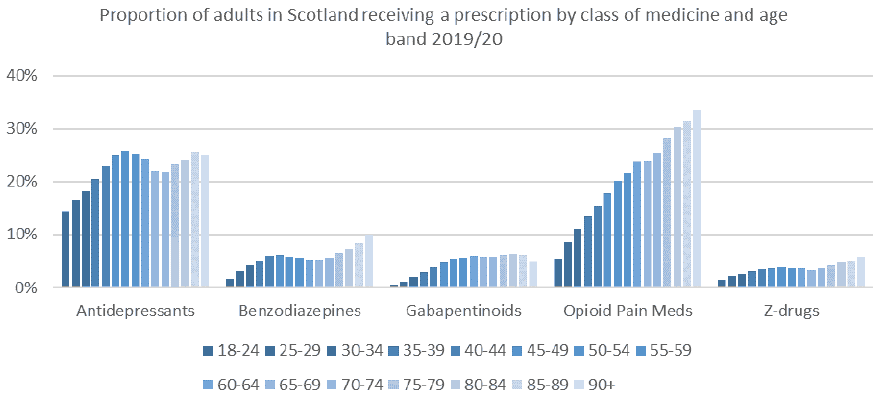
1.4.6 The use of opioid pain medicines shows a very clear pattern of increasing use with increasing age whereas for the other medicines classes there is a pattern of increasing use into middle age, followed by a period of slight decline and then increasing use in older age. The use of gabapentinoids, however, appears to decline in the oldest age groups. The same pattern was seen in England.
1.5 Overall Prescribing Trends
1.5.1 Figure 1.5 shows the proportion of adults in Scotland receiving at least one prescription by medicines class for the financial years 2010/11 to 2019/20. Table 1.6 shows this data as the number of adults in Scotland, to the nearest 5,000.
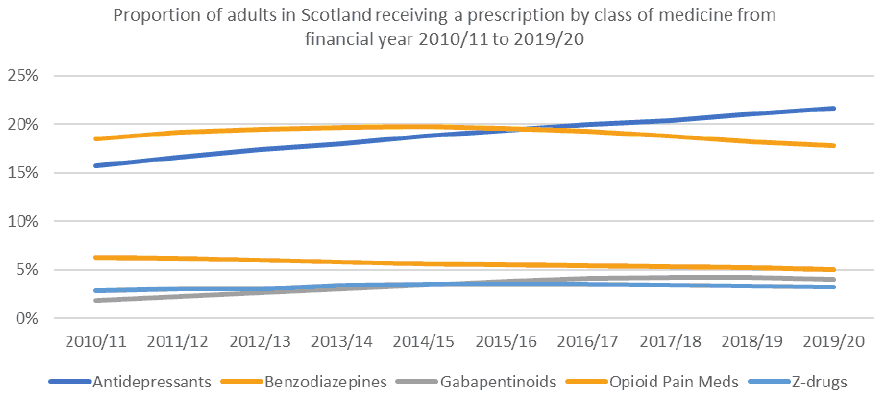
| Financial Year | Antidepressants | Benzodiazepines | Gabapentinoids | Opioid Pain Meds | Z-drugs |
|---|---|---|---|---|---|
| 2010/11 | 665,000 | 265,000 | 80,000 | 780,000 | 120,000 |
| 2011/12 | 705,000 | 265,000 | 95,000 | 815,000 | 130,000 |
| 2012/13 | 740,000 | 255,000 | 112,000 | 830,000 | 130,000 |
| 2013/14 | 770,000 | 250,000 | 130,000 | 845,000 | 150,000 |
| 2014/15 | 810,000 | 240,000 | 150,000 | 855,000 | 150,000 |
| 2015/16 | 840,000 | 235,000 | 165,000 | 850,000 | 150,000 |
| 2016/17 | 870,000 | 240,000 | 180,000 | 840,000 | 155,000 |
| 2017/18 | 895,000 | 235,000 | 185,000 | 825,000 | 150,000 |
| 2018/19 | 930,000 | 230,000 | 185,000 | 800,000 | 150,000 |
| 2019/20 | 960,000 | 225,000 | 180,000 | 790,000 | 145,000 |
1.5.2 Since 2010/11 antidepressant prescribing has increased from 15.7% to 21.6% of the adult population. This equates to around an extra 295,000 adults receiving an antidepressant medication in 2019/20 compared to 2010/11.
1.5.3 During the same period, opioid pain medicines, after having been increasing up to 2014/15, started to decrease so that in 2019/20, the proportion of the adult population in receipt had decreased by 0.7% in comparison to 2010/11.
1.5.4 Use of gabapentinoids has more than doubled since 2010/11, although this increase has levelled off since 2016/17 with a drop of 5,000 adults in the last year’s data.
1.5.5 Benzodiazepine prescribing has been reducing since 2010/11 with 40,000 fewer adults in receipt by 2019/20.
1.5.6 Increase in Z-drug use between 2010/11 and 2013/14 coincided with the drop-in prescribing rates for benzodiazepines and has since been declining. That said, by 2019/20 there were around 25,000 more adults receiving Z-drugs compared to ten years previously.
1.5.7 Figure 1.6 shows that age had an increasing effect on co-prescribing for adults receiving any of the classes up until the 60-64 age band- when the trend reverses. Co-prescribing in the 60-64 age band was 37.2% between January and March 2020. The lowest rate was seen in the 18-24 age band where 12.8% received a prescription for two or more classes of medicines.
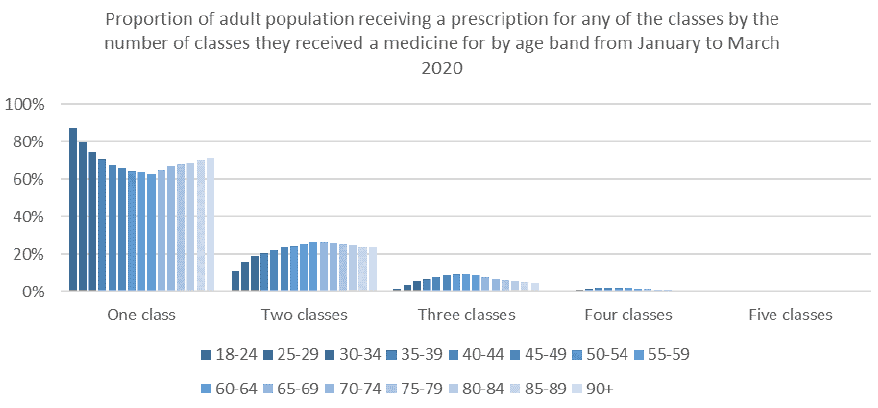
Comparison with England
1.5.8 The PHE report showed increases in the rate of prescribing in England for antidepressants between 2015/16 and 2017/18, from 15.8% of the adult population to 16.6%, and for gabapentinoids from 2.9% to 3.3%. These represent a 5% and 13% relative increase, respectively. There was a small decrease in prescribing rates for the other three medicine classes.
1.5.9 For the same time period, there was a similar pattern of change in Scotland although the proportions of adults receiving these medicines is generally higher in Scotland. For the same time period as the PHE report, the proportion of adults receiving antidepressants increased from 19.4% to 20.4% and gabapentinoids from 3.8 to 4.2%. These represent relative increases of 5% and 11% respectively.
2. Treatment duration
2.1 Introduction
2.1.1 Treatment duration was estimated by performing a retrospective analysis of the prescribing patterns for adults aged 18 years or over considered to be on a current course of treatment with an antidepressant, benzodiazepine, gabapentinoid, opioid pain medicine or z-drug in March 2018.
2.1.2 The analysis looked at the prescription history for these adults over the preceding 36 months. After allowing for a three-month gap in prescribing, see Annex A1, any adult considered to be currently receiving a medication in March 2018 was included in the analysis. Current treatment length was then estimated based on the number of months that had passed since a break in treatment greater than three months had last occurred (allowing for a three-month gap in prescribing).
2.2 Duration of current treatment
2.2.1 Most adults had been receiving treatment for 3 or more months (figure 2.1).
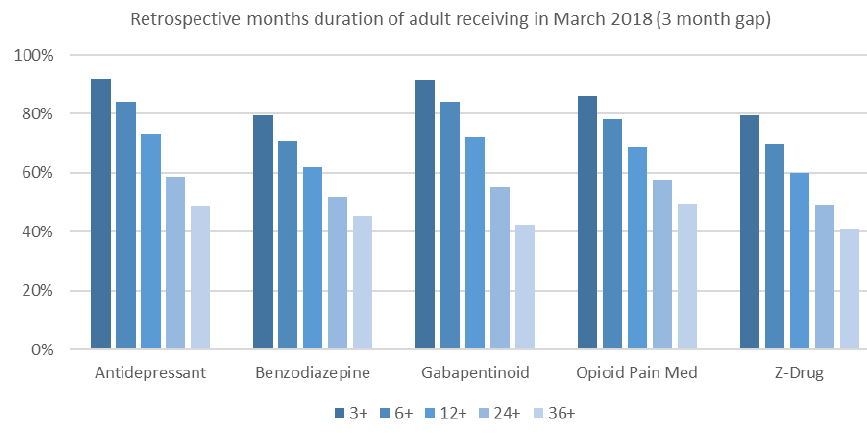
2.2.2 The proportion of adults who had been receiving treatment for 12 or more months ranged from 72.9% for antidepressants to 60.1% for z-drugs. Over 40% of adults in all medicines groups had been receiving treatment for three or more years.
2.1 Comparison with England
2.1.1 It is not possible to make direct comparison of the preceding figures with the PHE report due to the different methodologies. However, table 2.1 below, shows Scottish figures calculated using the PHE methodology alongside the corresponding figures from England.
| Drug Class | PHE (1 month gap) | Scotland (1 month gap) | Scotland (3 month gap) | |||
|---|---|---|---|---|---|---|
| < 3 months | ≥ 12 months | < 3 months | ≥ 12 months | < 3 months | ≥ 12 months | |
| Antidepressants | 17.7% | 52.1% | 20.0% | 47.8% | 8.1% | 72.9% |
| Benzodiazepines | 30.4% | 50.4% | 28.6% | 51.5% | 20.4% | 61.8% |
| Gabapentinoids | 16.8% | 53.3% | 17.2% | 53.3% | 8.5% | 72.1% |
| Opioid analgesics | 25.2% | 50.0% | 23.2% | 54.4% | 13.9% | 68.9% |
| Z-hypnotics | 25.5% | 53.3% | 27.8% | 50.9% | 20.4% | 60.1% |
2.2 Effect of deprivation
2.2.1 Figure 2.2 shows the proportion of adults with a treatment length of 12 months or more as a proportion of adults receiving treatment for each of the five medicines classes by SIMD quintile.
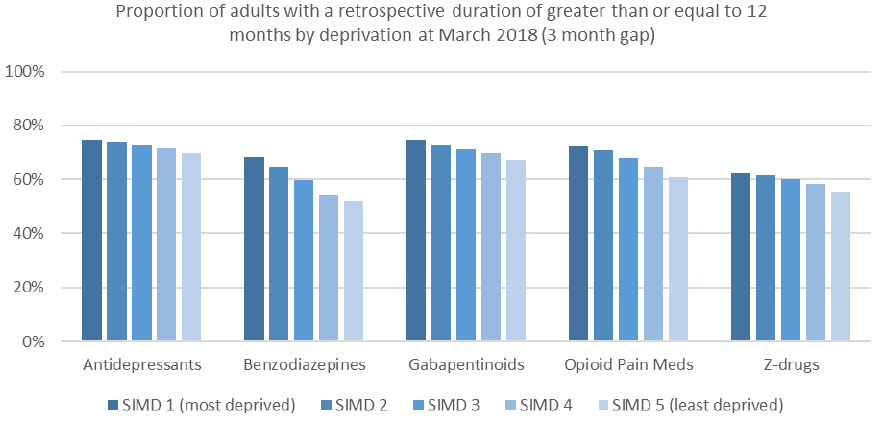
2.2.2 Deprivation has a consistent effect across all five classes of medicine, with higher proportions of currently treated adults from more socio-economically deprived groups having received treatment for 12 or more months.
2.2.3 This difference is most notable for benzodiazepine and opioid pain medicines with those from the most deprived communities being, respectively, 1.3 and 1.2 times as likely to have received treatment for 12 or more months as those from the least deprived communities.
2.3 Effect of gender
2.3.1 Figure 2.3 shows the proportion of adults with a treatment length of 12 months or more for each of the five medicines classes by gender.
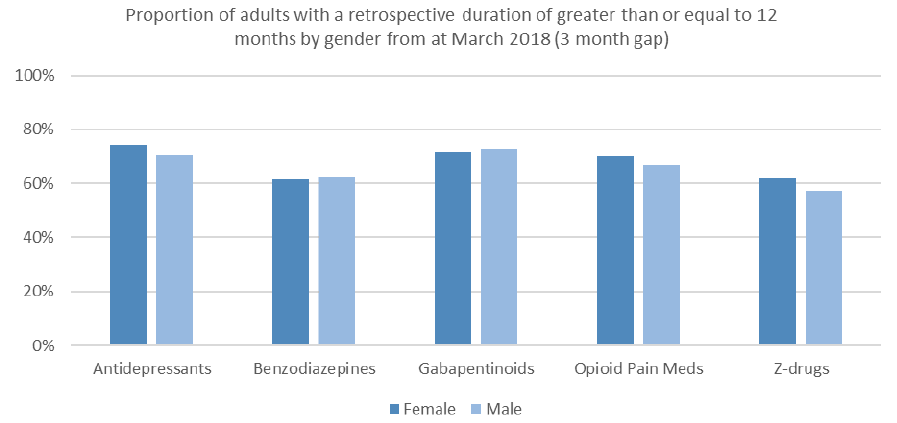
2.3.2 Females in current treatment were more likely than males to have been receiving antidepressants, opioid pain medicines and z-drugs for 12 or more months whereas males were marginally more likely to have been receiving benzodiazepines, and gabapentinoids for 12 or more months.
2.3.3 These gender differences were small, ranging from females being 1.1 times more likely to have been receiving a z-drug for 12 or more months to males being 1.01 times more likely to have been receiving a gabapentinoid for 12 or more months.
2.4 Effect of age
2.4.1 Figure 2.4 shows the proportion of adults with a treatment length of 12 months or more for each of the five medicines classes by five-year age band.
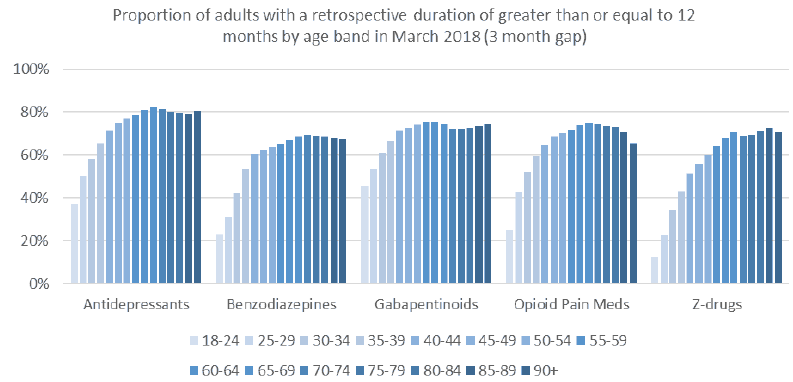
2.4.2 For all medicine types, the likelihood of having been receiving treatment for 12 or more months increases with increasing age. However, for benzodiazepines and opioid pain medicines there is a slight reversal of this in the oldest age groups.
2.4.3 From table 2.2 we can see that the likelihood of having been receiving treatment for 12 months or more for adults aged 80 years and over, compared with those under 35 years is 1.5 times as likely for antidepressants, 82.5% compared to 54.5%; 1.8 times as likely for benzodiazepine, 70.0% compared to 38.7%; 1.3 times as likely for gabapentinoids, 76.9% compared to 61.5%; 1.6 times as likely for opioid pain medicines, 74.1% compared to 47.1%; and 2.6 times as likely for z-drugs, 74.0% compared to 28.4%.
| Age Band | Antidepressants | Benzodiazepines | Gabapentinoids | Opioid Pain Meds | Z-drugs |
|---|---|---|---|---|---|
| 18-34 | 54.5% | 38.7% | 61.5% | 47.1% | 28.4% |
| 35-49 | 74.9% | 61.8% | 74.7% | 67.9% | 53.8% |
| 50-64 | 81.5% | 67.3% | 78.3% | 74.5% | 66.2% |
| 65-79 | 83.8% | 71.2% | 76.9% | 76.9% | 71.8% |
| 80+ | 82.5% | 70.0% | 76.9% | 74.1% | 74.0% |
3. Treatment trajectory
3.1 Introduction
3.1.1 The treatment trajectory for new individuals was estimated by performing a prospective analysis of the prescribing patterns for adults first prescribed an antidepressant, benzodiazepine, gabapentinoid, opioid pain medicine or z-drug in June 2015.
3.1.2 New individuals were identified as adults who first received a prescription in June 2015 and had no similar prescriptions in the preceding 12 months. The treatment was considered as stopped if there was no prescription recorded for four months or more (greater than a three month gap), see Annex A1.
3.1.3 These new individuals were followed for up to 40 months to determine the length of treatment that they received. Only the length of the treatment started in June 2015 was included in the analysis. Any new or repeat treatments started after the initial treatment had been considered to have ended were excluded. Individuals who had died before the end of the analysis period were removed from the prospective data as it could not be ascertained if the reason for ceasing treatment was due to the individuals’ death.
3.2 Duration of treatment
3.2.1 Many adults who had their first prescription in June 2015 received treatment for less than three months, ranging from 46.8% for gabapentinoids to 83.8% for benzodiazepines.
3.2.2 The proportion of adults continuing treatment for 12 months or more ranged from 4.0% for benzodiazepines to 29.4% for gabapentinoids.
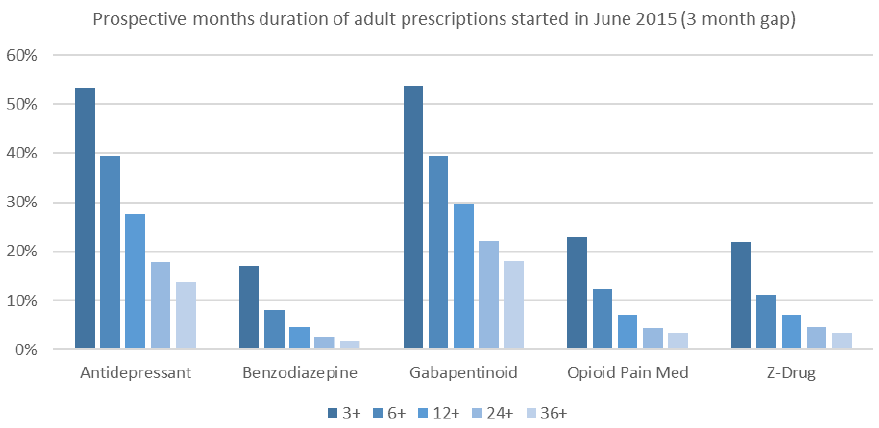
3.3 Effect of deprivation
3.3.1 Figure 3.2 shows the proportion of adults with a treatment length of 12 months or more for each of the five medicines classes by SIMD quintile.
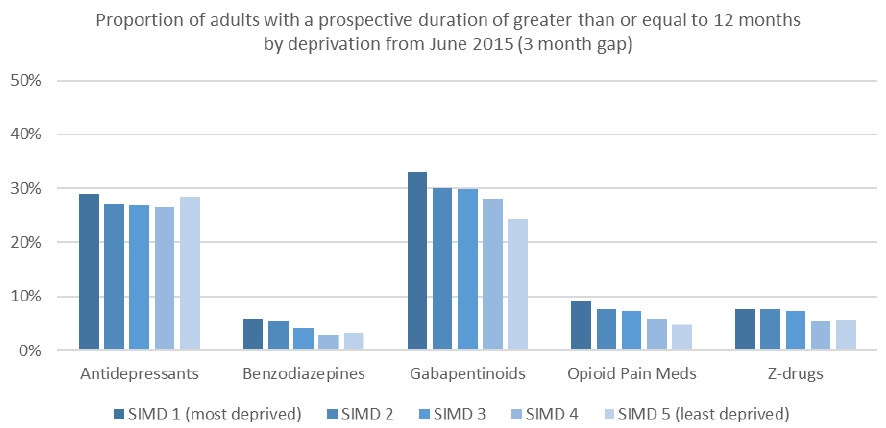
3.3.2 Deprivation has a tendency for higher proportions of those from more socio-economically deprived groups remaining on treatment for twelve or more months across all five classes of medicine. That said, 12 month or greater antidepressant use in the least deprived quintile does have a higher proportion receiving for 12 months than all but the most deprived quintile.
3.3.3 The difference between most and least deprived quintiles is most notable for benzodiazepine, gabapentinoids and opioid pain medicines with those from the most deprived communities being, respectively, 1.8 times, 6.0% compared to 3.3%, 1.4 times, 33.0% compared to 24.3% and 1.8 times, 9.0% compared to 4.8%, as likely to receive treatment for 12 or more months as those from the least deprived communities.
3.4 Effect of gender
3.4.1 Figure 3.3 shows the proportion of adults with a treatment length of 12 months or more for each of the five medicines classes by gender.
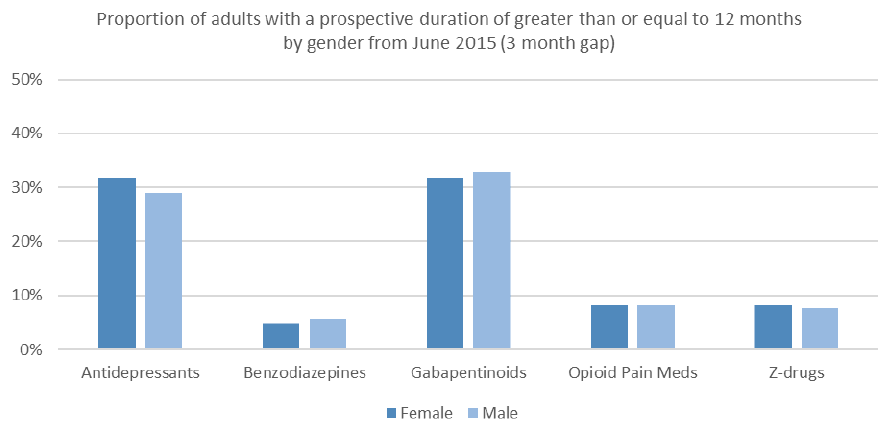
3.4.2 Females were more likely to receive antidepressants and z-drugs for 12 or more months whereas males were more likely to receive benzodiazepines, gabapentinoids and opioid pain medicines for 12 or more months.
3.4.3 These gender differences were modest, ranging from females being 1.1 times more likely to be on an antidepressant for 12 or more months to males being 1.2 times more likely to be on a benzodiazepine for 12 or more months.
3.5 Effect of age
3.5.1 Figure 3.4 shows the proportion of adults with a treatment length of 12 months or more for each of the five medicines classes by five-year age band.
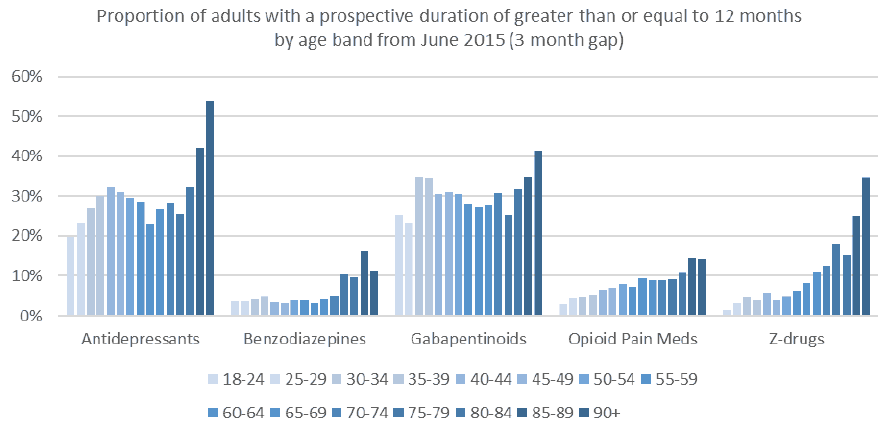
3.5.2 Older adults were generally more likely to remain on treatment for 12 or more months, although this was less marked for gabapentinoids.
3.5.3 For benzodiazepines, opioid pain medicines and z-drugs there is a generally increased likelihood of remaining on treatment for 12 or more months with increasing age, whereas for antidepressants and gabapentinoids there is a reduced likelihood in middle age compared with both younger and older age groups.
Annex A1 - Identifying the start and end of a treatment course
In order to estimate course duration, gaps in prescribing had to be allowed to prevent the assumption that a treatment course had ended prematurely due to prescribing frequencies rather than an actual break in treatment. Figure A1 shows prescribing for an individual with a three-month gap between prescriptions. If a prescription was received in January and May, allowing for three-month gap, it could be assumed that the individual was still receiving treatment through February, March and April. As no prescription was received in any of the four months before January, or the four months after May, it has been assumed that this treatment course lasted five months from January to May.
| Sep | Oct | Nov | Dec | Jan | Feb | Mar | Apr | May | Jun | Jul | Aug | Sep |
|---|---|---|---|---|---|---|---|---|---|---|---|---|
| Rx | Rx | |||||||||||
| Any gaps in prescribing that are three months or less are added (marked x) | ||||||||||||
| Sep | Oct | Nov | Dec | Jan | Feb | Mar | Apr | May | Jun | Jul | Aug | Sep |
| Rx | x | x | x | Rx | ||||||||
| Individual considered to be on a course of treatment between January and May | ||||||||||||
| Sep | Oct | Nov | Dec | Jan | Feb | Mar | Apr | May | Jun | Jul | Aug | Sep |
| Rx | x | x | x | Rx | ||||||||
The PHE report allowed for one-month gaps in prescribing for a treatment course to be considered as continuous. Because there may be specific repeat ordering/prescribing patterns associated with holidays (e.g. Christmas and Easter) and because 56-day prescribing is common for some of the medicines in Scotland, PHS considered that allowing a longer gap in prescribing would be more appropriate for its national analysis. The results of applying different lengths of gap are shown in the figure below. The results from the already established National Therapeutic Indicators (NTIs), which define long-term prescribing as an individual having been prescribed a medication in quarter 1 and quarter 8 of a 2 year period and having been in receipt of at least 10 prescription items over the same period of time, are shown for comparison.
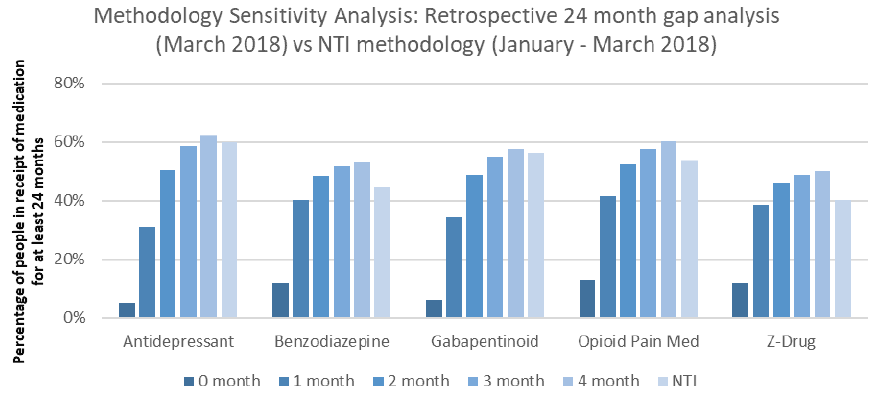
As can be seen, only a small proportion of individuals received a prescription every month and the proportion considered as receiving continuous treatment increases with the number of months considered a permissible gap. However, the magnitude of that increase reduces with each additional month of permissible gap. In comparison to the NTI methodology, a 3 to 4 month gap fits most closely for antidepressants and gabapentinoids; for opioid pain medicines a 2 month gap is closest; and for benzodiazepines and z-drugs a 1 and 2 month gap is closest.
We would therefore recommend that a gap of up to three months between prescriptions should be considered permissible when considering whether a series of prescriptions represent continuous treatment for each of the five classes. From a clinical perspective, it would seem that over a two-year period, ongoing prescribing with a gap between prescriptions of no more than three months, is indicative of an ongoing condition and continuous prescribing rather than intermittent and occasional acute treatment.
Contact
Email: stuart.law@gov.scot
There is a problem
Thanks for your feedback